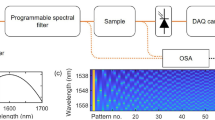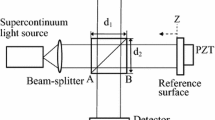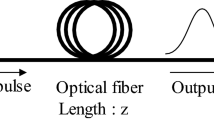Abstract
We experimentally demonstrate that the spectral resolution of Fourier transform interferometer could be greatly enhanced by using the dispersive property of semiconductor GaAs in the near infrared region and obtain the frequency distribution of the input light from interference pattern by defining a new frequency transform factor. The results show the effectiveness of this method in the slow light interference system.
Similar content being viewed by others
Avoid common mistakes on your manuscript.
1 Introduction
Recently, there has been considerable interest in developing practical applications of slow light method in many fields such as spectroscopy [1–4], telecommunication [5], and laser gyroscope [6]. In particular, recent research has experimentally demonstrated that slow light can be a very useful approach to improve the spectral performance of some kind of optical interferometers by using the materials with the large group index [1–4].
Fourier transform (FT) interferometry is a powerful technique which has basically high spectral resolution and excellent signal-to-noise ratio (SNR) [1, 7, 11]. These properties are widely applied to analyze the component of the matters in the biomedical engineering, food safety, and petrochemical engineering in infrared spectral region. Conventional optical interferometers usually contain non-dispersive materials (typically air) with refractive index n, which is practically equal to the group index n g (defined by n g ≡ n + vdn/dv) in the conventional optical materials. Therefore, the optical delay time (ODT) of the conventional interferometers can be determined by defining the optical path difference (OPD), and the ODT can be explained as \( \tau = {{nL} \mathord{\left/ {\vphantom {{nL} c}} \right. \kern-0pt} c} \), where nL is the OPD, and c is the speed of light in vacuum. Further, the spectral interval of the conventional FT interferometer (typically Michelson interferometer) is given by \( \delta v_{\rm{min} } = {1 \mathord{\left/ {\vphantom {1 {(2\tau_{\rm{max} } )}}} \right. \kern-0pt} {(2\tau_{\rm{max} } )}} = {c \mathord{\left/ {\vphantom {c {(2nL_{\rm{max} } )}}} \right. \kern-0pt} {(2nL_{\rm{max} } )}} \), where v is the frequency of input optical field, and nL max is the maximum OPD [7]. However, the phase and the group velocity of light are different from each other in a slow light material with a large dispersion. Thus, the optical delay time of the slow light FT interferometer could not satisfy the relationship mentioned above.
In this paper, we propose a new FT interferometer to realize the tunable group delay time between the two optical paths by continuously tuning the thickness of the slow light material as shown in Fig. 1. We propose a new method to describe the interference process of the FT interferometer and experimentally demonstrate that the spectral resolution of the FT interferometer can be greatly enhanced by using the large group index of slow light material, which is inversely proportional to the group delay time that can be achieved. Further, we directly obtain the frequency distribution of the input light from the interference pattern by defining a frequency transform factor. This enormous improvement in spectral performances can be used to decrease the weight and the volume of optical instrument without degrading the instrument performances.
2 Spectral resolution theory of slow light FT interferometer
Usually, slow light materials have large dispersion in the near resonance lines, which could lead to large group index. Moreover, the light propagation theory shows that the experimental measurement of the light velocity from the flight time should be the group velocity, but not the phase velocity, which is closely related to the group index of the materials [7]. Therefore, optical group delay time can be described as \( \tau_{\text{g}} = {L \mathord{\left/ {\vphantom {L {v_{\text{g}} }}} \right. \kern-0pt} {v_{\text{g}} }} = {{n_{\text{g}} L} \mathord{\left/ {\vphantom {{n_{\text{g}} L} c}} \right. \kern-0pt} c} \), where \( v_{\text{g}} = {c \mathord{\left/ {\vphantom {c {n_{\text{g}} }}} \right. \kern-0pt} {n_{\text{g}} }} \) is the group velocity of light, and L is the length of the material. Further, the optical group path (OGP) can be defined by the group index n g instead of the refractive index n in the conventional method as OGP = n g L, which could be directly used to describe the group delay time.
Typically, the main core of Fourier transform interferometer is using an optical structure to produce uniform time interval in the whole measurement. A Mach–Zehnder interferometer was used in this work. The setup is displayed in Fig. 1. The incident light is divided by a beam splitter BS1 into two beams: The transmitted beam travels to a continuously tunable slow light material to realize a tunable group delay time, and the reflected beam passes through a plate to compensate the initial optical path difference. We assume that a quasi-monochromatic light is used as the source of the interferometer, and the center frequency and linewidth are v 0 and Δv, respectively. Consequently, the output intensity of the interferometer is given by
where n(v) is the refractive index of the slow light material, n air is the refractive index of the air at the room temperature, c is the velocity of light in the vacuum, and ΔL is the lateral movement of the medium from zero to ΔL max. We assume that the initial optical path difference and the optical group delay time are zero in the optical system, which can be obtained by tuning the thickness of the materials. The output intensity of the interferometer can be described by the integral function with refractive index n(v) and ΔL. The refractive index of the material is not a constant but a function of the frequency of light in the spectral region. Therefore, the frequency of light and the optical path difference could not constitute the Fourier transform pairs simply, and we could not directly process the inverse Fourier transform with Eq. (1). Additionally, the relative group delay time between the two optical paths of the interferometer near v 0 can be calculated by
Thus, the Eq. (1) can be rewritten with the group delay time, and then, we can obtain the following inverse Fourier transform relationship:
where \( f = \frac{{n(v) - n_{\text{air}} }}{{n_{\text{g}} - n_{\text{air}} }}v \) is a transformed frequency, and the refractive index of the air is equal to the group index as n air ≅ n g,air. The frequency transform factor can be defined as ξ = [n(v) − n air]/[n g − n air]. If the differentials satisfy the condition of df = dv, the FT pair consists of the transformed frequency f and the group delay time τ g in the present optical system. Therefore, the input spectrum can be obtained by applying the FT and expressed with the output intensity as a function of group delay time τ g. This method could avoid the problem mentioned above and successfully configure the FT pair similar to conventional FT interferometer. The spectral resolution of slow light FT interferometer can be obtained by measuring the largest group delay time, which could be obtained in each optical path as δv = 1/12τ g,max = c/2(n g − n air)ΔL max. As mentioned above, the non-dispersive materials are usually used in conventional optical system. Thus, the spectral resolution of the conventional FT interferometer can be achieved and explained by δv = 1/12τ max = c/2(n 0 − n air)ΔL max instead of the slow light material in Fig. 1, that is, the spectral interval of the slow light FT interferometer can be enhanced (n g − n air)/(n 0 − n air) times under the same conditions, where n 0 is the refractive index of non-dispersive material.
3 Experiment structure parameter and optical property of slow light medium GaAs
A slow light Mach–Zehnder interferometer has been constructed to experimentally demonstrate the method as shown in Fig. 1. A LED-808 nm pumped single longitudinal mode non-planar ring oscillator Nd:YAG laser is used as the light source, whose output wavelength is 1064 nm and the FWHM is 2 GHz approximately as shown in Fig. 2. A high-resistance semiconductor GaAs is used as the slow light material. The maximum thickness ΔL max can be scanned for about 11.13 mm, and the initial thickness L 0 of GaAs is about 2 mm. The angle between the two surfaces is about 12°. It could assure the transmittance of light in the slow light material GaAs and the change ratio of thickness simultaneously. According to Kramers–Kronig relation [8], it has large dispersion in the near band gap edge. This property could give rise to the change in refractive index rapidly and obtain large group index in the near band gap edge. Numerically, the value of the refractive and group index of GaAs are 3.467 and 3.940, respectively, and the dispersion of group index is nearly zero near the spectral range of 1064 nm [9]. Further, we know the semiconductor GaAs is an isotropic electromagnetic medium. This is helpful for us to machine the material as requested. A translation stage with a resolution of 33 nm is used to continuously displace a wedge to tune its thickness and therefore to modulate the group delay in one arm of the interferometer. With the thickness increasing of the material, the optical path difference of the interferometer increases, along with the phase difference in the whole image area. We thus expect that the interference fringes will also move, and the corresponding intensity change can be determined by recording the intensity of patterns at one record point. The near infrared detector is used to measure the change of the intensity of the fringe patterns.
4 Experimental result and discussion
Figure 3 shows the experimental data for the variation of intensity I out as a function of the group delay time τ g at primary frequency of input light. Note that the output intensity I out is not convergent to zero when the optical group delay time achieved maximum τ max in present system, because the delay time is not long enough between the two arms, which is restricted by the size of slow light material. Moreover, the nonzero DC component about input intensity is preserved from the recorded fringes, since the thickness increase can enhance the absorption of the material GaAs and further influence the integral result of the input light. In Fig. 3, the interference diagram indicates a cosine function and meets the requirements of Fourier transform pair. The interference pattern is described above as shown in Fig. 3, and this is calculated by the FT relation of Eq. (3).
Figure 4(a) is the result of the directly calculated spectrum with obtained interference pattern. Note that the value of the frequency is 2.365882 × 1014 Hz, and the spectral resolution is 5 GHz approximately. This result is related to the transformed frequency f and satisfies the theory of mentioned above in Eq. (3). The measured spectral resolution differs slightly from the theoretical prediction, where the numerical values and the measured values are 4.6 and 5 GHz, respectively. This is because that the analysis in Eq. (3) is just under the ideal case. However, the slow light material has large dispersion and absorption in the practical situation. Figure 3 shows that it is difficult to obtain an interference diagram with high symmetry, due to various factors such as the effects of background light, errors of mechanical structure and optical path design, as well as the absorption and high reflectivity of GaAs. These factors further result in the noise peaks in Fig. 4 and exert a negative effect on the final experimentally measurable accuracy. This could make the intensity I in changes with the thickness tuning of the material and affect the result. Moreover, the effective linewidth of retrieved input light can be obtained as γ eff = cα/4π(n g − n air) in the system, where the light contains only an infinitely narrow spectral line centered at v 0 [1, 4]. It depends on the absorption coefficient α and the group index of the material. Through contrasting the FWHM linewidth with the experimental result, one can see that the FWHM linewidth is much less than the spectral resolution of the system. Thus, the result is determined by the spectral resolution of the experimental setup. Note that this result is different from a coefficient ξ with actual input spectrum (ξ = 2.467/2.94). Therefore, the actual input spectrum can be obtained from the transformed frequency f, and the result is shown in Fig. 4b. Here, the center frequency of actual input spectrum is about 2.819496 × 1014 Hz, where n(v 0) = 3.467, n g = 3.94, and n air = 1. Note also that the frequency agrees with the light source very well, and the slight difference of each other is perhaps introduced by the influence factors such as the mechanical vibration of the system, the process of approximating the refractive and group index in the whole spectral region, and the measuring inaccuracy of the experiment.
A significant part of the resolution improvement is due to the high refractive index of GaAs, regardless of its dispersion. If the resolution enhancement of the proposed method was to be compared with the resolution obtained with a non-dispersive optical material with the same refractive index as that of GaAs, the spectral resolution enhancement would be improved by a factor of about 1.2. However, it is worth noting that the high refractive index materials commonly used as optical materials are semiconductors that usually exhibit significant absorption features at larger group refractive index regime. Furthermore, they also exhibit high Fresnel reflectance because of their large refractive index. To reduce the energy loss in the measurement, non-dispersive media (such as SiO2 or K9 glass) with high transmissivity but lower absorption are preferably chosen. As it is difficult to find a non-dispersive optical material with high refractive index and low absorption features that exhibits the required conditions, we compared the spectral resolution of GaAs with that of SiO2 instead of making the comparison with a non-dispersive material having a refractive index around 3.48. When SiO2 (with a refractive index of about 1.45) is employed as optical material instead of the slow light material in Fig. 1 [10], the spectral resolution is approximately 30 GHz. Thus, the spectral resolution of a FT interferometer is enhanced approximately six times when the slow light material GaAs is used instead of SiO2.
5 Conclusion
In conclusion, we proposed a new method to describe the slow light FT interferometer and analyzed the interference process in detail. A transformed frequency f and group delay time are introduced as the Fourier transform pairs and used to directly calculate the spectral resolution of FT interferometer. We have experimentally demonstrated that the spectral resolution of the interferometer is closely related to the maximum group delay time and the frequency distribution of light. When compared to a system using SiO2 in the same conditions, the spectral resolution is enhanced by approximately a factor of six. This enhancement is limited by the group index of GaAs. Moreover, some slow light methods can achieve larger group delays, and this could conduce to higher gains of spectral resolution [12].
References
Z. Shi, R.W. Boyd, R.M. Camacho, P.K. Vudyasetu, J.C. Howell, Slow-light Fourier transform interferometer. Phys. Rev. Lett. 99, 240801 (2007)
Z. Shi, R.W. Boyd, D.J. Gauthier, C.C. Dudley, Enhancing the spectral sensitivity of interferometers using slow-light media. Opt. Lett. 32, 915–917 (2007)
M. Chamanzar, B. Momeni, A. Adibi, Compact on-chip interferometers with high spectral sensitivity. Opt. Lett. 34, 220–222 (2009)
Z. Shi, R.W. Boyd, Slow-light interferometry: practical limitations to spectroscopic performance. J. Opt. Soc. Am. B 25, C136–C143 (2008)
R.W. Boyd, D.J. Gauthier, A.L. Gaeta, Applications of slow light in telecommunications. Opt. Photon. News 17, 18–23 (2006)
Y. Zhang, H. Tian, X. Zhang, N. Wang, J. Zhang, H. Wu, P. Yuan, Experimental evidence of enhanced rotation sensing in a slow-light structure. Opt. Lett. 35, 691–693 (2010)
P. Hariharan, Optical Interferometry, 2nd edn. (Elsevier, Amsterdam, 2003)
R.W. Boyd, Nonlinear Optics, 2nd edn. (Elsevier, Amsterdam, 2003)
B. Jensen, A. Torabi, Dispersion of the refractive index of GaAs and AlxGa1-xAs. IEEE JQE 19, 877–882 (1983)
R. Kitamura, L. Pilon, M. Jonasz, Optical constants of silica glass from extreme ultraviolet to far infrared at near room temperature. Appl. Opt. 46, 8118–8133 (2007)
T. Okamoto, S. Kawata, S. Minami, Optical method for resolution enhancement in photodiode array Fourier transform spectroscopy. Appl. Opt. 24, 4221–4225 (1985)
J.B. Khurgin, R. Tucker, Slow Light: Science and Applications (Taylor & Francis Group, Milton Park, 2009)
Acknowledgments
We thank the reviewers for their helpful comments on this article. We thank Professor Baoquan Yao and Xiaoming Duan of HIT for their offering the source of light. The authors acknowledge the financial support from the National Natural Science Foundation of China under Project Nos. 61405146 and 11304225, and Tianjin Research Program of Application Foundation and Advanced Technology 14CQNJC01700.
Author information
Authors and Affiliations
Corresponding author
Rights and permissions
About this article
Cite this article
Cai, Y.X., Ming, C.G., Ren, X.B. et al. Enhanced spectral resolution of NIR Fourier transform interferometer based on the dispersive property of GaAs. Appl. Phys. B 122, 208 (2016). https://doi.org/10.1007/s00340-016-6483-z
Received:
Accepted:
Published:
DOI: https://doi.org/10.1007/s00340-016-6483-z








